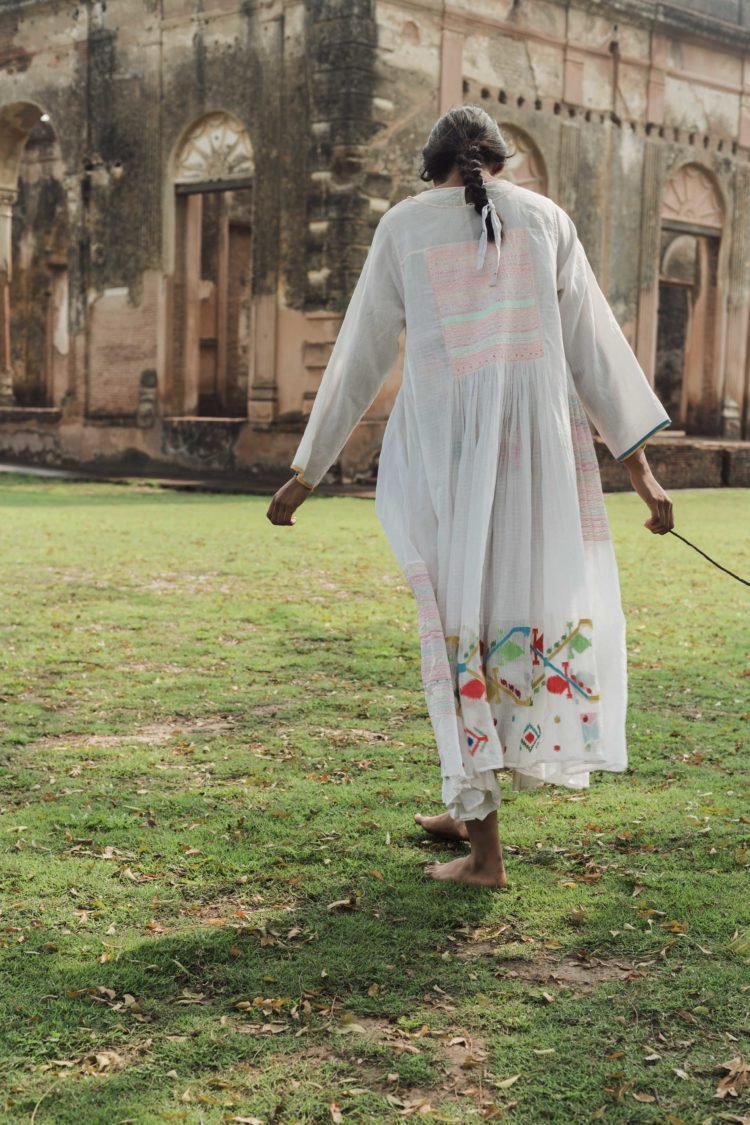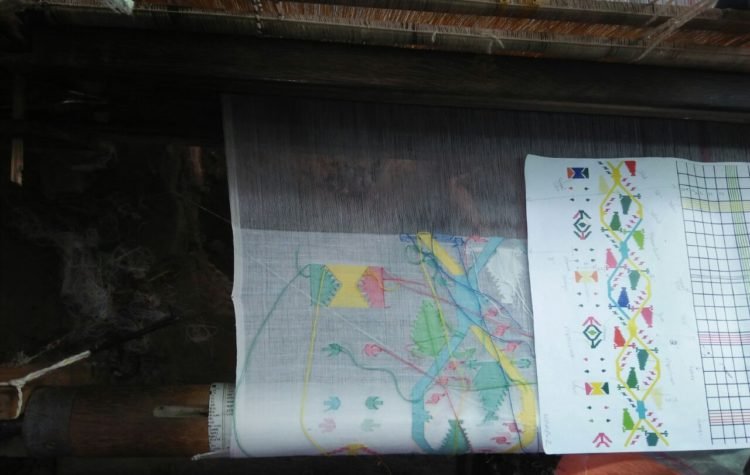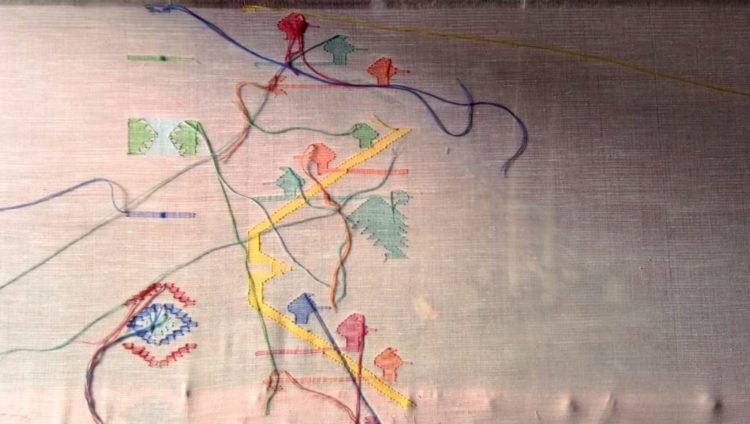14.05.2020
Jamdani – Quietness Of Jamdani

Having its origin in Dhaka, Bangladesh, Jamdani, which is more popularly called Dhakai Jamdani has always been seen as an enchanting textile. Some referred to it as ‘woven air’ while others called it the ‘flowered and figured’ muslin owing to the name ‘jamdani’ which is derived from ‘jama’ meaning flower and ‘dani’ meaning vase. Jamdani collectively stands for handwoven cotton sarees and yardages highlighting beautiful floral motifs. The creation of this elegant fabric takes its time since it is handwoven and extra weft made from slightly thicker yarn is interlaced using a shuttle with the standard weft threads to create the motifs.
The intricate jamdani work is mostly done by men until they are 50-55 years old, but women in a few households do it as well. The plain weaving work is usually done by old men, while the bobbin filling, denting, and drafting work is usually done by women. Not all weavers are capable of weaving all types of jamdani; only a few are capable of weaving large borders, and only a few master artisans can weave all types of small buta works, and only a few master artisans can weave all types of intricate jamdani jaals.
What makes the Jamdani weaving process unique is the fact that the designs are not drawn on the fabric. Instead, the designs are made on translucent graph paper which is placed under the warps. Each motif used in this technique has a unique name based on what it represents, such as panna hajar (thousand emeralds), kalka (paisley), butidar (small flowers), fulwar (flowers arranged in straight rows), tersa (diagonal patterns), jalar ( motifs covering the entire saree), dhuria (polka spots) and charkona (rectangular motifs).
The spinning of yarn for the warp and weft begins the process of making a jamdani fabric. Jamdani fabrics were typically made of 200-250 count handspun cotton yarns, but according to many books and studies on these ancient textiles, fabrics as high as 300-500 count were woven. Handspinning is a technique that involves spinning cotton balls with a charkha to create yarn. The spinner would rotate the handle of the charkha with the other hand while holding a raw cotton ball in one hand, gradually converting the cotton into a long and slightly uneven strand of yarn. It may break several times while being spun, but the spinner joins the two ends with a slight twist of their fingers and resumes spinning. The spinning now takes place mostly on the ambar charkhas in these areas. These are semi-automated charkhas, in which mill-produced cotton sliver is hand spun into fine yarns. These ambar charkhas are now mostly made with 100-150 count yarn, but mill spun 80-100s yarn is also used.
The yarns are then sent to be dyed if the fabric requires it. Because this village lacks the ability to dye yarns, it is sent to the villages of Phulia and Shantipur, which are both well-known for Jamdani weaving. After that, the dyed or undyed cotton hanks are taken to be starched. The fine cotton yarn used for the base fabric must be starched to give it strength so that it does not break during weaving and can withstand the loom’s tension. As a starch, Sabu (sago) paste is used. These yarn hanks are then sun-dried, making them extremely stiff and hard. These yarns are taken to a spinner, who soaks the stiff hanks in water for a brief period of time so that the starch does not wear off and the yarn strands can be easily un-wound, then spins them into smaller hanks and dries them in the sun again. Locals refer to this process as Suto-Nataano.
These yarn hanks are un-wound onto bobbins (Nola) for warping in the next step, known as Nola-bhorna. Patkathi bobbins are typically handcrafted (dried jute plant sticks).

Warping, also known as drumming, is a process in which a horizontal drum is used to create a warp based on the colour pattern, width, and length of the fabric. According to the length of the entire warp, one full round of this drum is approximately 2.25 mt. or 90″. These warp threads are stretched to their full length and wound onto the Naroj warp beam. This naroj is given for the Shana-Bo process. Drawing these warp yarns through the shaft (Bo) and the Reed is a manual process (Shana). It’s done in two shafts in a simple straight draught pattern (each thread through alternate shafts and 2 threads per dent). The fine 100’s-150’s cotton or khadi yarn is mostly 84-90 reed count.
To set up the loom for weaving, these parts are taken and joined and tied with various other parts. Jamdani is mostly woven in this area on a pit loom, which is a four-poster loom set into the ground with an overhang lay for the shafts and paddles, which are placed in a small pit. The shafts are tied together with many small sticks known as Nachon Khathi and paddles known as Pasa Noli, which determine the up-and-down motion of the warp, known locally as Jhaanp, for the insertion of the weft yarns. Rail Pati refers to the frame in which the reed is mounted and the shuttle moves.
The weaver incorporates supplementary weft to create the motifs in the jamdani fabric using a discontinuous extra weft technique. They make these inlay patterns with Soonch, a long metal needle that the weaver inserts between the warp threads according to the pattern to be made and pulls the extra weft yarn through, creating the looped inlay pattern. The graph patterns are used to determine the placement and size of the motifs on the fabric.
Depending on the pattern’s complexity, it’s sometimes traced or drawn on the warp with washable inks. The extra weft is usually made of 6-8 ply yarn. In Bangla, the throw shuttle for the base is known as Maku, and the small bobbin inside it is known as Noli.
Warp threads can break while weaving if they aren’t properly starched or aren’t starched at all. That is why weavers continue to spray starch on the loom’s warp in order to keep the delicate yarns stiff enough to weave. They also use a shoe brush with fine bristles to detangle and straighten the threads, as well as wax to allow the threads to pass smoothly through the shafts and reed, resulting in less friction and less yarn breakage. Every time they unroll the warp beam after weaving a few inches of fabric, they go through the same procedure.
After that, the woven fabrics are washed twice or three times to remove all of the starch from the yarns.
There are several kinds of jamdani sarees in accordance with the types of motifs used and the patterns created. Phool Paar is a jamdani saree that has floral borders on all sides of the saree without any other motif on the body. Phool Bel Laka Konia saree is one that has floral borders on all four sides in addition to paisley motifs at each corner. The body of this saree may have floral or geometric patterns. Padma Jaal Dhakai saree has lotus motifs woven throughout the saree in a mesh pattern, like a brick repeat pattern. Phool Bel saree refers to a floral vine border sari. Apart from floral motifs, jamdani sarees are also known to incorporate motifs of fruits, animals and birds like the Anarosh Aachol saree showcasing pineapple motifs at the corners and Paakhi Kor saree showing bird’s wings on the borders.

Jamdani is considered to be one of the most expensive fabrics in the world because it is delicately handwoven. Jamdani artisans are capable of achieving highly realistic motifs that look almost the same as a real flower, something one would think of achieving only by embroidery. However, due to price constraints, the artisans are required to simplify the motifs so that the designs are more feasible. One is mesmerized while looking at the jamdani fabric from a distance, for it seems the motifs float as the base fabric is lightweight and has a sheer feel to it highlighting only the motifs.
The use of bright colours is a comparatively newer addition to the white on white jamdani tradition. Using bright shades of red, yellow, green and blue on the white or black surface has become a distinguishable part of Bengal Jamdani sarees. Inspired by these colourful jamdani sarees, Injiri classic garments are indulged with coloured border details.
Play of extra weft on superfine khadi, simplicity can be achieved using complex weaving techniques and that for Injiri is important. Weaving motifs with supplementary weft inlay technique or jamdani allow for the play of forms on a solid colour. This Injiri or garments as it’s known commonly consists of a jamdani woven border broken up and deconstructed in Muslin Khadi. The supplementary weft which is the unique technique of the Jamdani weave, makes the inlay designs come on the panel of the garments in a scattered format.
